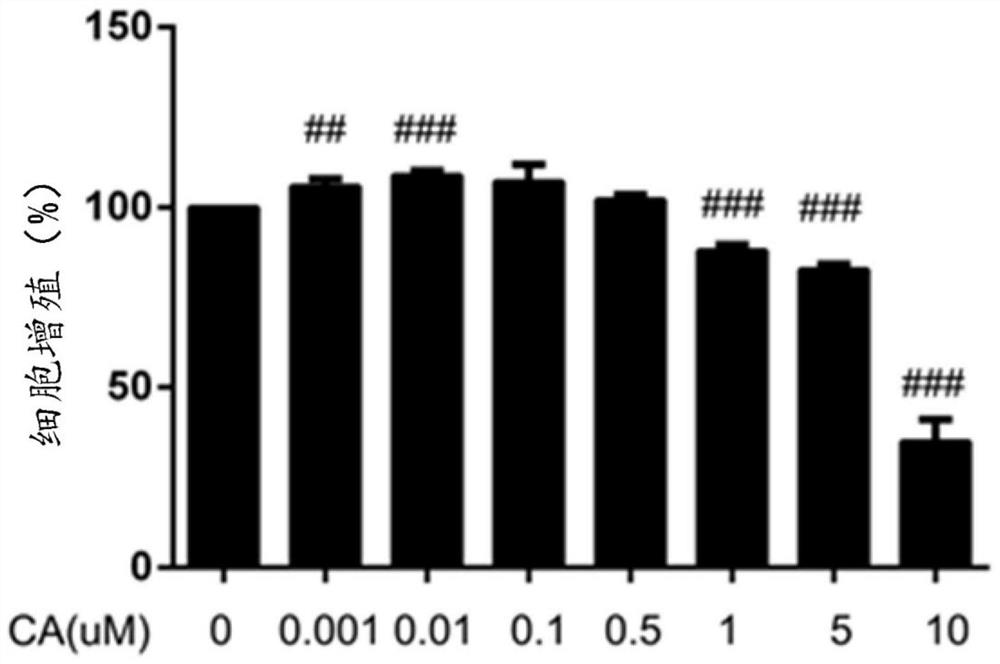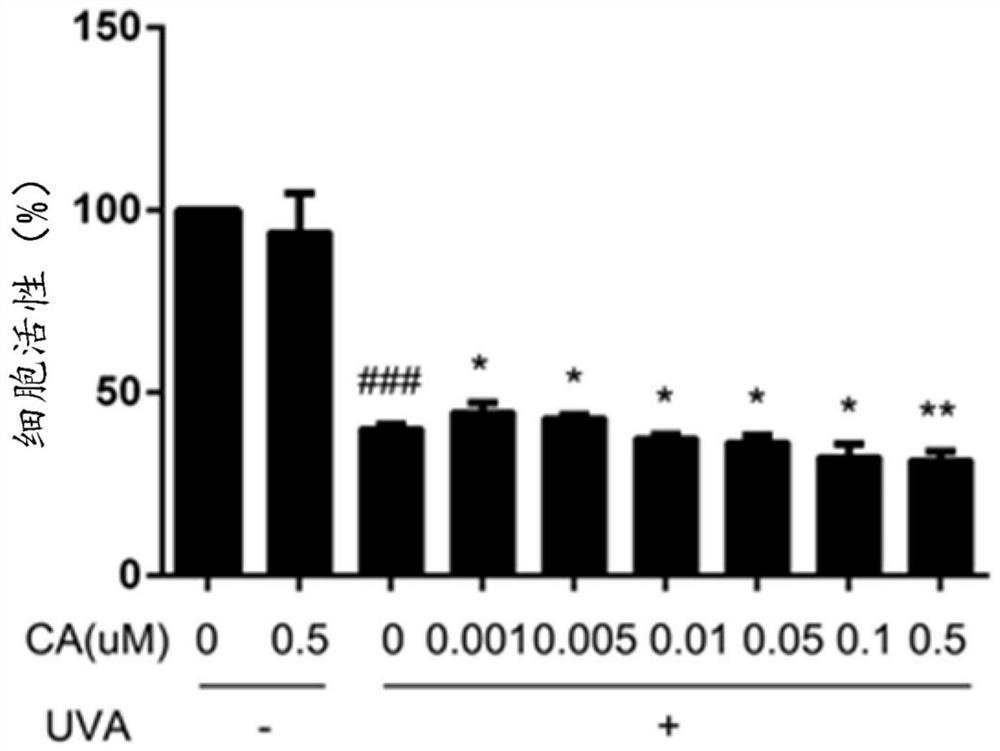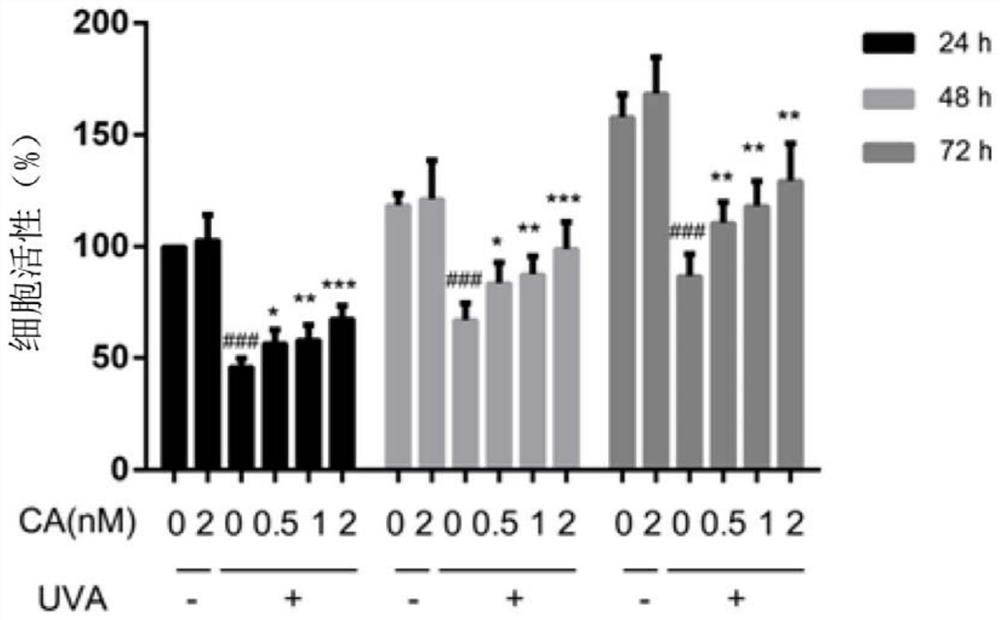Application of carnosic acid in preparation of anti-photoaging product
A carnosic acid, anti-photoaging technology, applied in the field of medicine, to achieve the effect of natural materials and broad market prospects
- Summary
- Abstract
- Description
- Claims
- Application Information
AI Technical Summary
Problems solved by technology
Method used
Image
Examples
experiment example 1
[0031] Experimental Example 1: Effect of carnosic acid on the cell activity of human skin fibroblasts:
[0032] Prepare carnosic acid solutions (0.001, 0.01, 0.1, 0.5, 1, 5, 10 μM) containing the following different concentrations, and use the MTT method to detect the effect of carnosic acid (CA) on the cell viability of human skin fibroblasts, such as figure 1 shown. figure 1 Each data in the table is represented by mean ± standard error, n=3. Compared with the blank control group (control), # P## P### P<0.001; compared with the light group (UVA), *P<0.05, **P<0.01, ***P<0.001.
[0033] figure 1 The results show that when the concentration of carnosic acid is below 0.5 μmol / L, it will not inhibit the activity of human skin fibroblasts; when the concentration of CA is 1 μmol / L and 5 μmol / L, it can affect the activity of human skin fibroblasts , compared with the control group, there was a statistical difference (P<0.001); when the concentration of carnosic acid was 10 μM, ...
Embodiment 2
[0034] Example 2 Effect of carnosic acid on the cell activity of human skin fibroblasts after UVA irradiation:
[0035] 1. Prepare carnosic acid solutions (0.001, 0.005, 0.01, 0.05, 0.1, 0.5μM) containing the following different concentrations, and use UVA (10J / cm 2 *3d) Human skin fibroblasts were irradiated, and the above-mentioned different concentrations of carnosic acid solutions were added to treat for 2 hours before and after each irradiation. After the treatment, the culture was continued for 24 hours, and the effect of carnosic acid (CA) on human skin fibroblasts was detected by MTT method. The effect of the cell activity, the results obtained as figure 2 shown.
[0036] From figure 2The results showed that when the concentration of carnosic acid was 0.1-0.5 μM, it had a certain inhibitory effect on the proliferation of human skin fibroblasts, and compared with the control group, there was a statistical difference (P<0.05); when the concentration of carnosic acid ...
Embodiment 3
[0039] Anti-photoaging pharmacological research experiment of embodiment 3 carnosic acid:
[0040] 1. Carnosic acid inhibits UVA-induced β-galactosidase activity in human skin fibroblasts: in UVA (10J / cm 2 *3d) Human skin fibroblasts were treated with different concentrations of CA (0.5, 1, 2nM) before and after irradiation, and the β-galactosidase activity was detected with a β-galactosidase staining kit.
[0041] Figure 4 Carnosic acid inhibits UVA-induced cell staining positive rate of β-galactosidase activity in human skin fibroblasts, where the abscissa is the CA concentration of the cells treated with CA, and UVA(-) is UVA-irradiated , UVA (+) means after UVA radiation, and the ordinate indicates β-galactosidase staining. From Figure 4 The results showed that after UVA irradiation, compared with the control group, the positive rate of cell staining was significantly higher, with a statistical difference (P<0.001), suggesting that the aging model of fibroblasts irrad...
PUM
 Login to View More
Login to View More Abstract
Description
Claims
Application Information
 Login to View More
Login to View More - R&D
- Intellectual Property
- Life Sciences
- Materials
- Tech Scout
- Unparalleled Data Quality
- Higher Quality Content
- 60% Fewer Hallucinations
Browse by: Latest US Patents, China's latest patents, Technical Efficacy Thesaurus, Application Domain, Technology Topic, Popular Technical Reports.
© 2025 PatSnap. All rights reserved.Legal|Privacy policy|Modern Slavery Act Transparency Statement|Sitemap|About US| Contact US: help@patsnap.com



